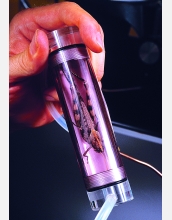Multimedia Gallery
Insect Respiratory Research
An American locust (Schistocerca americana) used in insect respiratory research.
More about this Image
Scientists know through fossil evidence that insects of giant proportions existed millions of years ago during the Paleozoic era (245-570 million years). Hundreds of species evolved during the later portion of this era, then disappeared just about the time the first dinosaurs appeared.
Recent geologic findings indicate that there was a greater amount of oxygen in the atmosphere 300 million years ago than there is today. During this period, the oxygen concentration in the air reached 35 percent, almost double the present level of 21 percent. Oxygen concentration stayed high for about 100 million years, then dropped precipitously to about 15 percent. Scientist think that the then-recent evolution of oxygen producing land plants caused this oxygen peak. Interestingly, the rise and fall of atmospheric oxygen also coincided with the evolution and extinction of giant insects. This has led to the hypothesis that the evolution of Paleozoic insect giants was made possible by elevations in atmospheric oxygen.
Is current insect maximal body size limited by atmospheric oxygen levels, and were the giant insects of the past caused by such atmospheric variation? Dr. Jon Harrison, a physiologist and professor of biology has received NSF funding to address these questions. Why might atmospheric oxygen levels limit insect maximal size? One possibility is that it is more difficult for larger insects to obtain oxygen, because they must deliver their oxygen to their cells via blind-ended tubes called trachea. Dr. Harrison has been testing this idea using grasshoppers such as the American locust (Schistocerca americana). He compares the ability to deliver oxygen for grasshoppers of different sizes. Oxygen delivery capacity is evaluated by seeing how well these animals cope with low oxygen and exercise, and by studies of their respiratory structures. Harrison is also rearing insects (grasshoppers and fruit flies) in various oxygen atmospheres.
Credit: John C. Phillips, Arizona State University, Research Magazine
Images and other media in the National Science Foundation Multimedia Gallery are available for use in print and electronic material by NSF employees, members of the media, university staff, teachers and the general public. All media in the gallery are intended for personal, educational and nonprofit/non-commercial use only.
Images credited to the National Science Foundation, a federal agency, are in the public domain. The images were created by employees of the United States Government as part of their official duties or prepared by contractors as "works for hire" for NSF. You may freely use NSF-credited images and, at your discretion, credit NSF with a "Courtesy: National Science Foundation" notation.
Additional information about general usage can be found in Conditions.
Also Available:
Download the high-resolution TIFF version of the image. (3.4 MB)
Use your mouse to right-click (Mac users may need to Ctrl-click) the link above and choose the option that will save the file or target to your computer.

